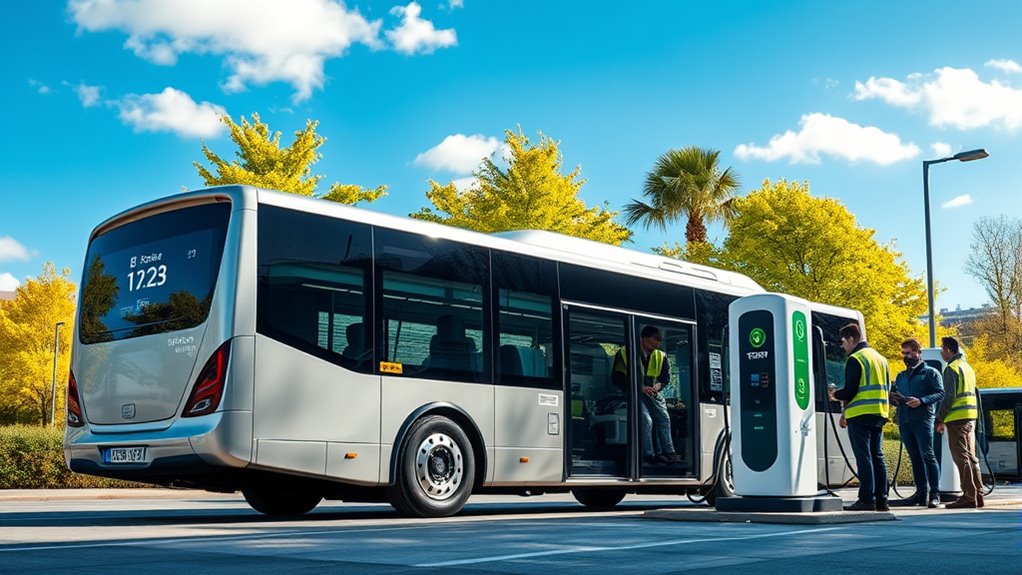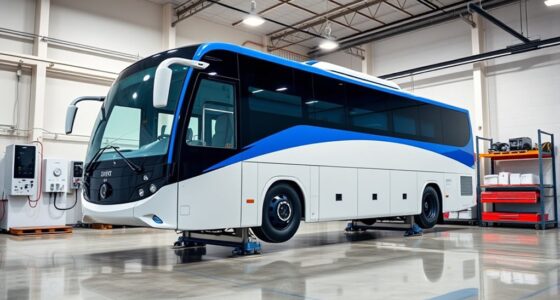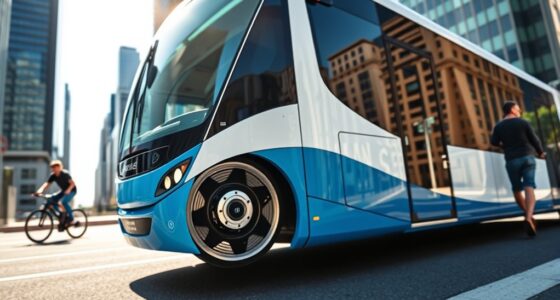To maximize battery life in electric buses, you should focus on maintaining ideal temperatures using thermal management systems like cooling and environmental controls, which prevent overheating or freezing. Monitoring battery health in real time with advanced systems helps detect issues early. Adopt proper charging strategies, such as avoiding deep discharges and balancing load demands. Regular predictive maintenance and embracing innovative battery tech improve longevity. For deeper insights, there’s more to explore on how combining these approaches can extend your bus batteries’ performance.
Key Takeaways
- Maintain optimal temperatures (15–35°C) using thermal management systems like liquid cooling to prevent overheating and degradation.
- Implement real-time battery monitoring and predictive maintenance to detect issues early and optimize performance.
- Use appropriate charging strategies, such as opportunity or overnight charging, to avoid deep discharges and extend battery lifespan.
- Protect batteries from impacts, vibrations, and moisture through proper installation, venting, and environmental controls.
- Promote sustainability with battery recycling, reuse, and adopting advanced, longer-lasting battery technologies.
Understanding the Importance of Thermal Management

Thermal management is essential for maintaining ideal battery performance in electric buses. It helps extend battery life by keeping temperatures within optimal ranges, reducing degradation over time.
When your batteries stay cool during hot days, they operate more efficiently and lose less energy to heat, which boosts overall energy efficiency.
Consistent thermal conditions also improve reliability, meaning fewer breakdowns and operational interruptions.
By managing heat effectively, you can save money by reducing costly replacements and maintenance.
Plus, good thermal management offers operational flexibility, allowing your electric bus to perform well across various environmental conditions.
Proper thermal systems ensure your bus’s batteries remain healthy and dependable, supporting long-term performance and cost savings.
It’s a critical element in maximizing your electric bus’s lifespan and effectiveness.
Maintaining Optimal Temperature Ranges for Batteries
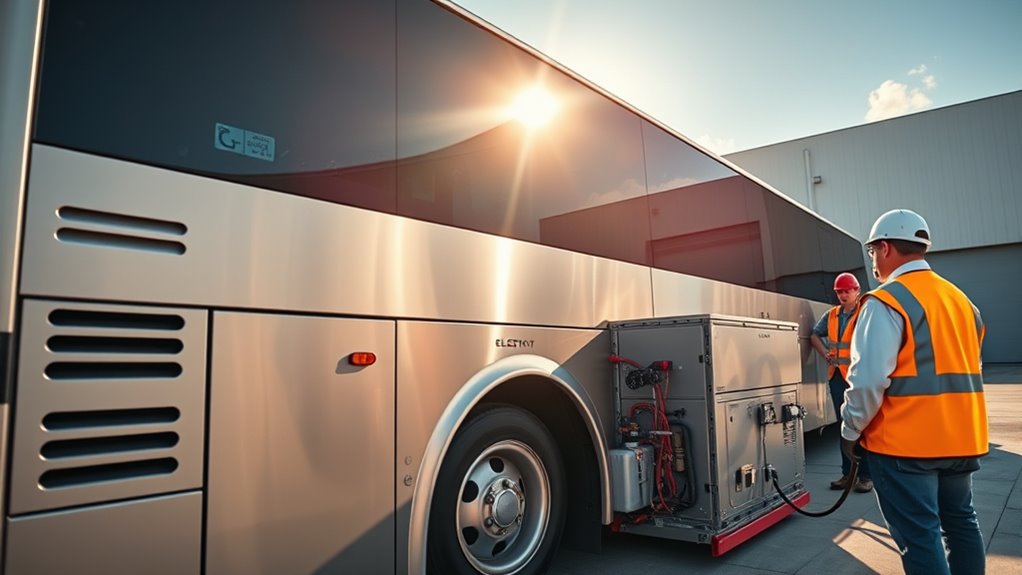
Maintaining the right temperature range for your electric bus batteries is key to ensuring they perform reliably and last longer. Batteries operate best between 15–35°C (59–95°F), so keeping them within this range prevents capacity loss and degradation. Proper installation and venting are essential to avoid temperature fluctuations and gas buildup that can harm battery health. Cold weather slows battery reactions, increases energy needed for cabin heating, and reduces overall range. To counter this, use thermal management systems that regulate battery temperatures, and store buses indoors when possible. Preconditioning is especially effective; preheating batteries to around 60°F–75°F while plugged in prepares them for service and improves efficiency. Additionally, implementing advanced thermal management can further optimize battery temperature control, reducing energy drain and prolonging battery lifespan. Maintaining optimal temperatures with temperature sensors helps detect and respond to fluctuations promptly, further safeguarding battery health. Proper temperature management minimizes energy drain, maintains battery health, and extends lifespan, ensuring your bus remains reliable and cost-effective over time.
Leveraging Real-Time Monitoring With Advanced Battery Management Systems
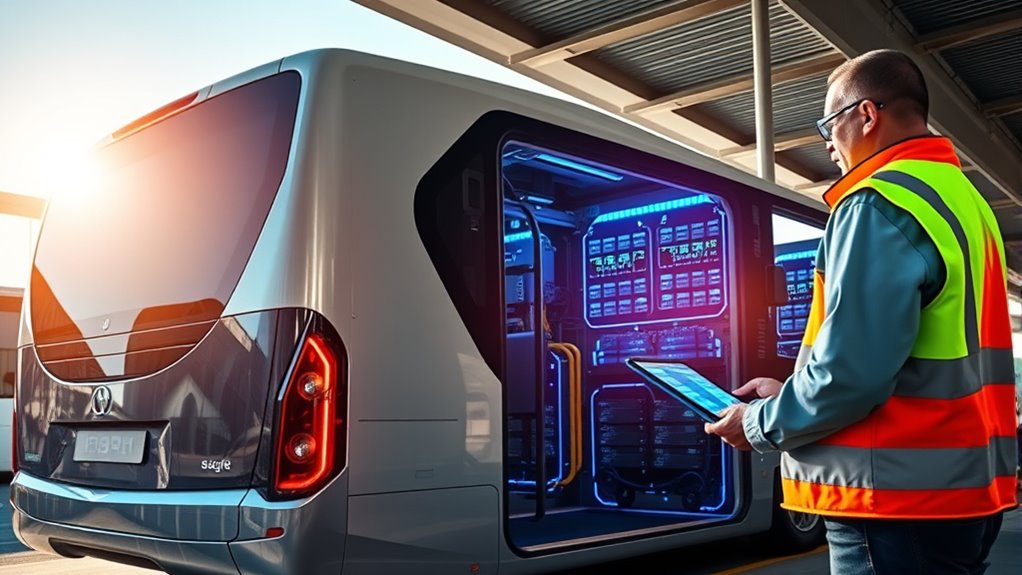
Leveraging real-time monitoring with advanced battery management systems (BMS) allows you to keep a close eye on your electric bus batteries, ensuring peak performance and longevity. With tools like Ebusco Live, you get instant data on battery status and efficiency, enabling you to optimize charging times and extend battery life. Incorporating accurate data collection from these systems ensures more reliable insights into battery health and performance. These systems analyze performance patterns, helping you predict potential issues before they become serious. Integration with diagnostic tools like TNO’s CheckUp provides on-site battery health assessments, while software like Volytica offers seamless monitoring through digital dashboards. AI-powered automation further enhances the accuracy and speed of data analysis, supporting more effective maintenance strategies. Using real-time insights, you can make data-driven decisions on route adjustments and maintenance schedules, reducing downtime and costs. Additionally, understanding battery degradation mechanisms allows for more precise interventions to maximize battery lifespan. Staying informed about chemical composition and other factors influencing battery health can also improve predictive maintenance accuracy. Ultimately, leveraging these advanced systems enhances your fleet’s efficiency and supports sustainable operation.
Implementing Effective Charging and Discharging Strategies
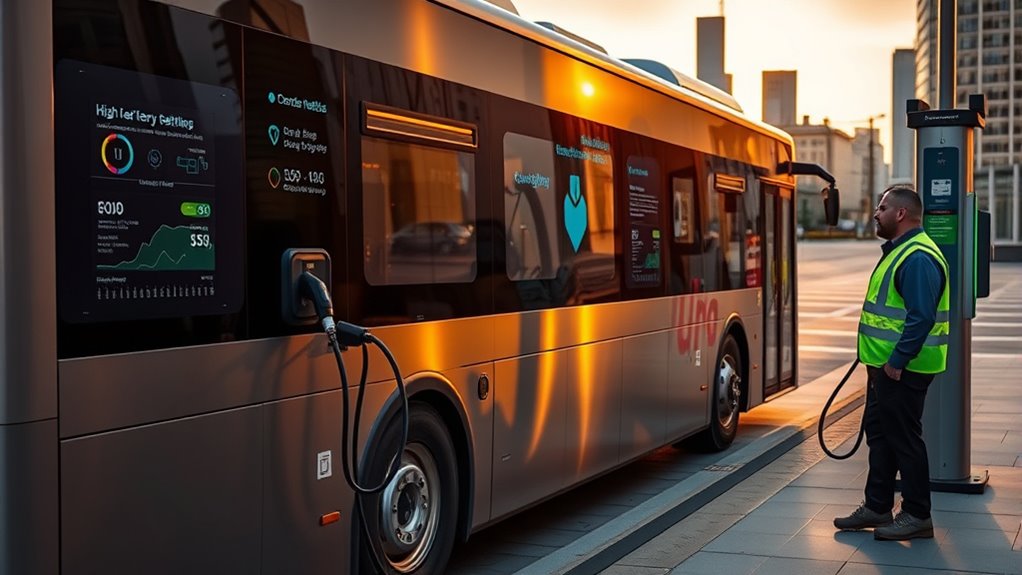
Implementing effective charging and discharging strategies is essential to guarantee battery life and ensure reliable operation of your electric buses. Begin by choosing the right charging method: overnight or depot charging suits short routes with larger batteries, while opportunity or flash charging allows quick top-ups during operation, but requires additional infrastructure. Use CCS plug chargers for flexibility and efficiency. Manage discharging by maintaining consistent rates to prevent rapid depletion, avoiding deep discharges with regular partial charges, and controlling temperature extremes to optimize efficiency. Plan routes carefully to ensure buses finish before needing recharges, and manage passenger loads to reduce discharge stress. Incorporate technologies like regenerative braking and efficient charging algorithms to enhance energy recovery and minimize waste, extending your batteries’ lifespan and operational reliability. Additionally, understanding the automation technologies involved can help optimize charging schedules and maintenance routines for better efficiency and lifespan.
Utilizing Predictive Maintenance and Analytics
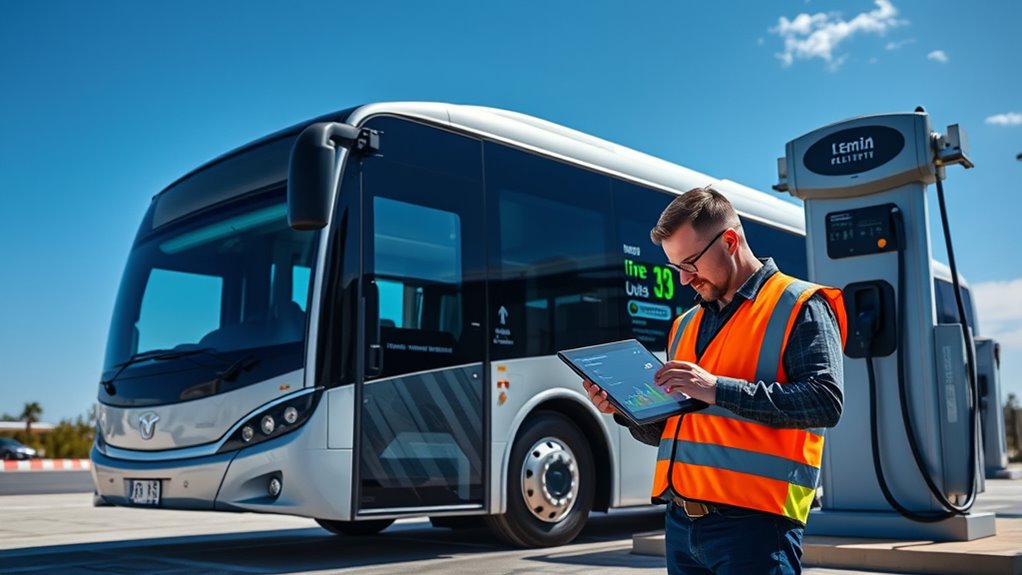
Utilizing predictive maintenance and analytics transforms how you manage electric bus fleets by enabling proactive detection of potential issues before they cause failures.
By analyzing real-time sensor data with advanced algorithms, you can identify problems early, reducing unnecessary repairs and costs. AI-driven insights help you monitor battery health continuously, preventing degradation or safety hazards like fires. Additionally, integrating cybersecurity measures ensures that your predictive platforms remain protected from potential cyber threats, safeguarding sensitive fleet data. Incorporating angel number insights can also offer spiritual guidance and reassurance during these technological upgrades, fostering a balanced approach to innovation.
Analyzing real-time sensor data with AI helps prevent battery issues and safety hazards like fires.
These tools allow you to optimize maintenance schedules, minimizing unplanned downtime and extending component lifespan, including batteries. Implementing predictive platforms like Stratio provides scalability and extensive data collection, ensuring accurate predictions. Employing diagnostic tools enhances your ability to troubleshoot issues more efficiently, saving time and resources.
This proactive approach enhances fleet reliability and efficiency, allowing you to allocate resources more effectively. Ultimately, predictive maintenance and analytics enable you to keep electric buses operating smoothly, maximizing their performance and battery life.
Additionally, addressing AI vulnerabilities and ensuring safety measures are in place is crucial for maintaining trust and preventing potential issues.
Adopting Best Practices for Operational Flexibility
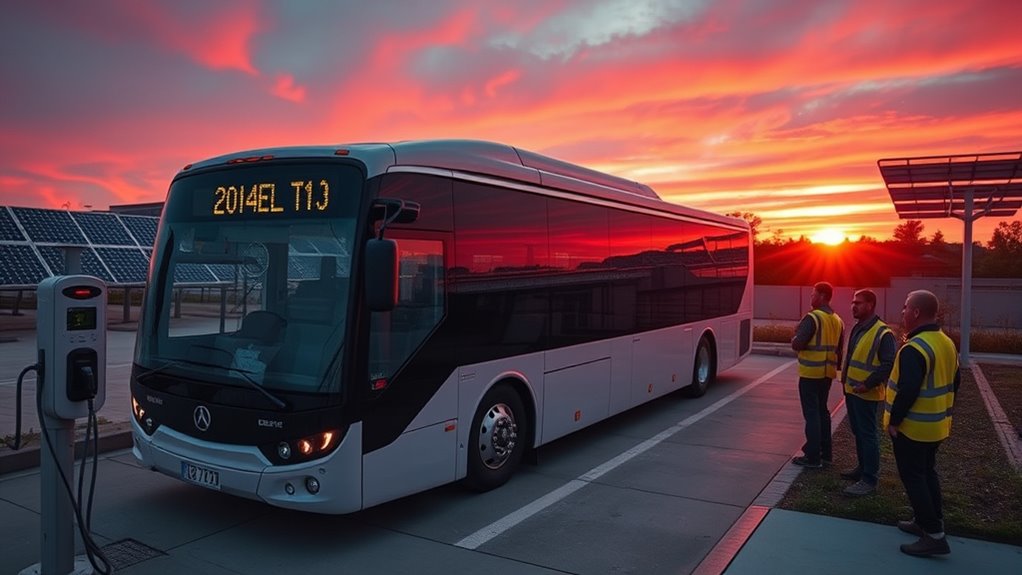
Managing an electric bus fleet requires more than just maintenance and analytics; it demands operational flexibility to adapt to changing conditions and optimize performance. To effectively implement space management strategies, consider the unique layout and storage needs of your fleet and facilities. Maximize space and organization ensures that charging stations, maintenance areas, and storage are efficiently arranged to support operational agility. Incorporating software tools can streamline planning and scheduling processes, leading to more adaptable operations. You should match your bus fleet size to your charging infrastructure, avoiding overextension that could hinder operations. Flexibility in adjusting routes, schedules, and maintenance routines helps accommodate differences between electric and traditional buses. Utilizing advanced planning software simplifies complex decisions around fleet deployment and charging needs. Considering high-pressure application techniques can improve efficiency when managing maintenance and refueling routines for your fleet. Properly assessing cost factors such as infrastructure, maintenance, and procurement is crucial for sustainable operations and resource allocation. Learning from early adopters’ case studies can guide you in making effective operational adjustments.
Enhancing Battery Longevity Through Environmental Control
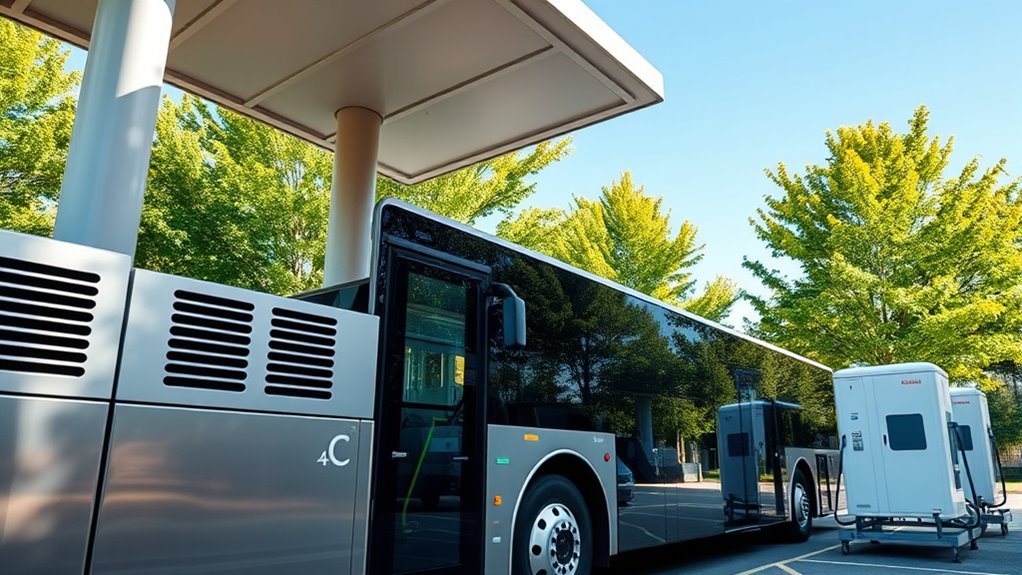
Environmental control plays a critical role in extending the lifespan of batteries in electric buses. Extreme temperatures can speed up degradation, so maintaining ideal thermal conditions is essential. High humidity levels risk moisture damage, which can cause short circuits and reduce battery life. Proper air circulation helps dissipate heat, preventing thermal stress, while advanced cooling technologies like liquid cooling offer more effective temperature regulation. Monitoring systems enable real-time tracking of environmental conditions, allowing for quick interventions. Additionally, understanding Volkswagen Tuning techniques can inform customized cooling solutions to optimize battery performance. Protecting batteries from physical impacts and vibrations preserves their structural integrity. Temperature management strategies are crucial in regions with significant climate variations, requiring tailored management strategies. Incorporating battery diagnostics can further enhance maintenance schedules and prevent failures before they occur. Moreover, implementing environmental sensors can provide precise data to optimize operational conditions and extend battery longevity.
Embracing Technological Innovations in Battery and Thermal Technologies

Advancements in battery and thermal technologies are transforming the landscape of electric bus performance. Solid-state batteries improve energy density and safety by replacing liquid electrolytes with solid materials, reducing thermal risks.
Solid-state batteries boost safety, energy density, and thermal stability in electric buses.
Lithium-sulfur batteries offer longer lifespan and higher energy density, ideal for extended routes.
Niobium-based anodes in next-generation lithium-ion batteries can boost charging speeds and overall efficiency.
Enhanced lithium-ion batteries now feature better energy density and management systems, maximizing range. Battery management systems play a critical role in optimizing performance and extending battery life.
Thermal management systems, along with advanced cooling and insulation techniques, maintain ideal battery temperatures, preventing overheating and extending lifespan.
Continuous thermal monitoring ensures safety and performance. Implementing thermal regulation can further prevent temperature fluctuations that degrade battery health.
Additionally, implementing well-maintained thermal regulation enhances battery longevity by efficiently controlling temperature fluctuations during operation.
These innovations allow for faster charging, more flexible routes, and safer operation, helping you maximize battery life and improve the overall reliability of your electric bus fleet.
Promoting Sustainable Practices for Battery Recycling and Resource Use

As electric bus technology continues to evolve, ensuring that battery use aligns with sustainable practices becomes increasingly important. Recycling batteries reduces reliance on virgin materials by breaking down plastics, metals, and minerals for new production, cutting emissions by up to 80%.
Implementing policies like extended producer responsibility ensures manufacturers take back and recycle used batteries, preventing landfill waste. Digital identifiers such as Battery Passports improve traceability and encourage recycling efforts.
Additionally, second-life use extends battery lifespan by repurposing batteries with at least 70% capacity for energy storage or smaller applications, reducing waste. Embracing circular economy practices—like refurbishing, recycling, and partnering with recycling firms—maximizes resource efficiency.
These strategies promote environmental responsibility while capturing economic value, making battery management sustainable and beneficial for the long term.
Optimizing Fleet Operations for Extended Battery Performance
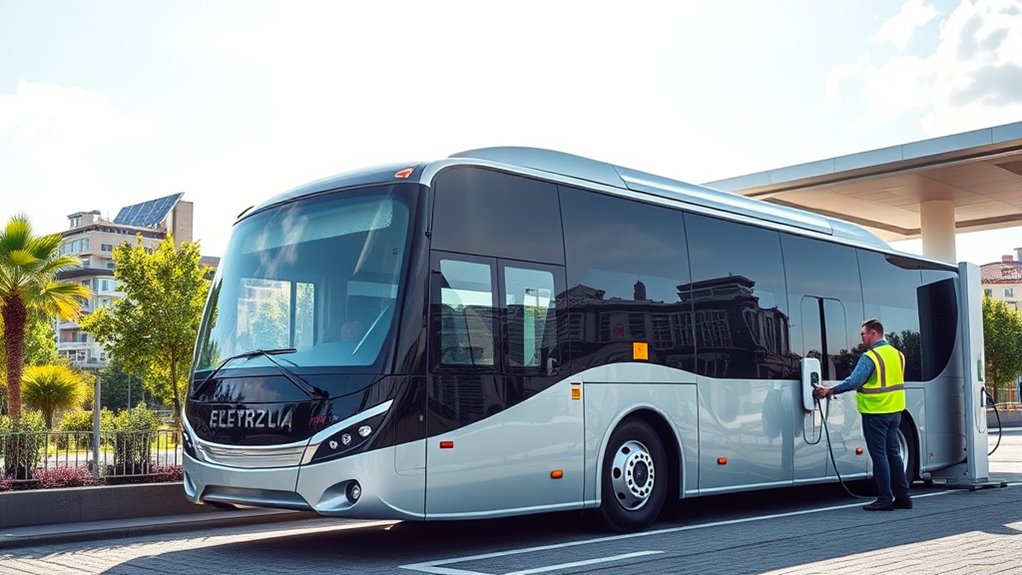
To maximize battery life in electric bus fleets, optimizing operational strategies is essential. You should implement load balancing to distribute power efficiently among charging stations based on real-time demand, preventing energy waste.
Peak shaving helps reduce consumption during peak hours, lowering costs and demand charges.
Effective depot space management ensures proper layout, accommodating charging infrastructure while maximizing vehicle storage.
Vehicle scheduling aligns buses with routes and charging needs, minimizing downtime.
Monitoring energy use in real time reveals areas for operational improvement.
Strategic placement of charging stations along routes minimizes energy waste and ensures continuous operation.
Evaluating grid capacity guarantees your infrastructure matches power needs without overloads.
These combined tactics extend battery lifespan, improve fleet efficiency, and lower operating costs.
Frequently Asked Questions
How Does Battery Type Influence Overall Lifespan and Performance?
The battery type you choose directly impacts lifespan and performance. Lithium-ion batteries, especially LFP, offer longer cycle life and safety, making them ideal for durability.
NMC batteries provide higher energy density for better range but may degrade faster. Your decision depends on the balance between longevity, safety, and performance needs.
Proper management, charging habits, and environmental conditions further influence how well your battery performs over time.
What Are the Signs Indicating Imminent Battery Capacity Degradation?
You should watch for signs of imminent battery capacity degradation, such as a noticeable reduction in the bus’s range, slower charging times, and decreased overall performance.
If you see error messages or if the State of Health (SOH) monitoring dips below 70%, it’s a clear indicator.
Regularly tracking these signs helps you catch issues early, preventing unexpected breakdowns and costly replacements.
How Can Operator Training Improve Battery Management Practices?
You can improve battery management practices through thorough operator training. It teaches you to monitor battery health in real-time, use predictive analytics, and understand degradation factors.
Training also covers best practices for preventive maintenance, safety protocols, and effective charging techniques. With hands-on exercises and expert insights, you’ll develop skills to optimize battery performance, reduce costs, and ensure long-term reliability of your electric bus fleet.
What Role Do Seasonal Changes Play in Thermal Management Effectiveness?
Seasonal changes markedly influence your bus’s thermal management effectiveness. Cold weather diminishes battery capacity and efficiency, so you’ll need to preheat batteries and adjust HVAC settings to sustain performance.
In hot seasons, cooling systems work harder to prevent overheating, increasing energy use. By adapting your thermal management strategies seasonally—like insulation upgrades and route adjustments—you guarantee ideal battery function and longevity despite temperature fluctuations.
How Do Emerging Materials Science Developments Impact Future Battery Longevity?
Did you know that new cathode and anode materials can double a battery’s lifespan? These emerging developments, like iron chloride cathodes and niobium oxide anodes, improve stability, reduce degradation, and enable faster charging.
You’ll benefit from longer-lasting batteries, fewer replacements, and enhanced safety. By integrating these innovations, you’re shaping a future where electric bus batteries perform better over time, even under demanding conditions.
Conclusion
By prioritizing thermal management and embracing innovative technologies, you can markedly extend your electric bus batteries’ lifespan. When you monitor conditions in real time and adopt sustainable practices, it’s like giving your fleet a hidden edge—sometimes, the smallest adjustments lead to the biggest gains. Ultimately, optimizing operations and caring for resources isn’t just good science; it’s a smart way to guarantee reliability and sustainability, turning everyday challenges into opportunities for lasting success.
